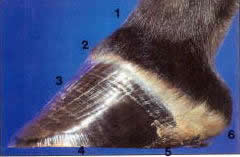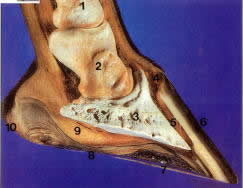|
|
Knowing
Your Horse's Feet-- Inside and Out
"Farrier-Friendly"™
series By Bryan
S. Farcus, BS, CF and Clyde
H. Alloway, JR. DVM
Examining The Externals

As I reflect back
on the years that I have spent learning and teaching, I admit that in
the beginning, it would have been very easy to be mislead. Whether we
are willing to admit it or not, we are virtually at the mercy of those
"first impressions". In some respects, I have been lucky because my first
teachers, and my current mentors, made sure that I approached my work
with pride and diligence. I was often told, as we all are, that we should
never dismiss the obvious and that many complex problems can be solved
with the most basic approaches. When you examine and begin to learn about
your horse's feet, I urge you to follow the same advice. In this article,
I share these pages with my colleague, Clyde Alloway DVM, so that we might
enhance your understanding of the external characteristics and the inner
mechanism of a horse's hoof.
First let's discuss
appearances. What should you see in a healthy hoof? These are a few fundamental
observations:
- The term "foot"
is used rather loosely. By its use, it infers a description of the entire
hoof structure (inner, as well, as outer). The external appearance of
a hoof is a reflection of its internal health.
- A hoof wall, that
is healthy, will have an enamel or "shine". This is generated by a healthy
periople (the human equivalent would be the cuticle of your finger or
toe nail). The health of the periople is dependent upon the health of
the horse's coronary band (horn-producing structure). When the coronary
band is healthy, it provides the horse's hoof with the appropriate levels
of moisture absorption or retention (repelling excess moisture). Hence,
the appearance of a nice "shiny" hoof wall. If your horse is experiencing
any stress, mechanically or metabolically, horizontal rings on the outer
wall may become noticeable.
- The sole (bottom
surface of the hoof), can appear in three forms:
- "concaved"
or "cupped" sole- this form is generally the best because it allows
the foot to have clearance from any rough or rocky terrain.
- "flat" sole-
this conformation, though it is manageable, is not desired due to
its direct contact with the ground. Often times, flat pads between
the hoof and shoe are necessary to prevent bruising.
- "dropped" sole-
this is a sure indication of internal hoof disease. In most cases,
the sole becomes dropped when the horse's bone column rotates, or
shifts. Terms commonly used to describe this condition are "laminitis"
or "founder". Dropped soles are very painful for most horses.
- The hoof to pastern
alignment or "natural angle" is also worth noticing. This alignment
is a clue as to how much mechanical stress your horse's limbs may be
under. If the pastern bones (bones resting directly above the hoof capsule)
and the hoof capsule are not directly underneath each other, the horse's
limb is said to be "overloaded". Simply stated, this means too much
weight is burdening either the toe area or the heel area, instead of
each bearing equal weight or "load".
- The length of the
foot. As a general rule, limbs with longer pasterns will tend to have
longer feet. Conversely, horses with shorter pasterns will , most generally,
have shorter feet. The goal of a farrier should be to strive for evenness
of toe lengths within a given pair. Barring any birth defects, or conformational
developments, most horse's hooves will grow or wear rather evenly, when
trimmed to their "natural angle".
- The "white line"
is often overlooked because the name is somewhat misleading. Perhaps,
if it were referred to as a "yellow" or "brown" line it would be easier
to spot. On an untrimmed bottom surface of a hoof, it appears as a "brownish"
groove that separates the inner edge of the hoof wall and the surface
of the sole. When inspecting a recently trimmed hoof, it usually appears
as a "yellowish" line. The "white line" is considered healthy if it
bonds the wall to the sole without any deep penetrating cracks. As a
rule of thumb, the horse's foot is said to be healthy if the hoof wall
is approximately two times greater than the thickness of the adjoining
white line. For most horses the white line is usually 1/8 inch or 3
mm in width.
An Internal Insight

As mentioned previously,
in almost every instance, what you'll notice on the outside of your horse's
feet is a reflection of those inner structures. Many farriers will say
that "good feet must be grown to shape, not just cut to shape". As a practicing
veterinarian over the past 28 years, I've had the opportunity to observe
a variety of situations and have drawn the following conclusions:
- Protein is important
for the proper development and maintenance of the hoof as well as other
tissues in the body. Weanlings should receive 16-18% protein in the
diet, active adults 12-14% , idle adults 10-12%.
- Some hooves are
softer and tend to grumble (break) more easily at the end of the hoof
wall. I have recommended the addition of dry, unflavored gelatin to
the horses grain to help "toughen" them.
- Horses kept in
constant high moisture areas tend to have increased problems with thrush.
Supplementing the diet with iodine can help prevent this problem. In
certain situations, I have recommended Ethyodide Powder. Also, remember
that the "power of a hoof pick" should not be under-rated.
- Laminitis is a
persistent threat to the horse. Many times this problem is subsequent
in nature and can be prevented:
- Never feed moldy
feed stuffs to horses.
- Always make sure
horses are properly "cooled-out" before allowing them to drink water.
- Change feed stuffs
gradually. Mix new with old in ever increasing ratios over a period
of 1-2 weeks, until the horse is on all new diet. This is especially
true when changing from grass to legume hay. When changing to a grass
pasture diet (especially to lush pasture), do so by starting with 10
minutes of eating time on day 1 and increasing by 10 minutes per day
over a 1-2 week period.
- Be aware of the
type of stall bedding you choose. Shavings with the bark of black walnut
trees (Juglans nigra) are highly toxic to the horse. Absorption of negative
acids, through the pores of the hoof, will trigger laminitis within
24 hours after exposure.
- Complications in
the foaling process can cause prolonged retention of the placenta. Generally,
it should be passed as early as 3 hours; no later than 8 hours. Regulated
doses of oxytocin can help, but forceful "tugging" to expel the placenta
can cause irreversible injury.
In closing, allow
me to emphasize the importance of a daily health care routine for your
horse. Most often the advice or treatments offered by your farrier or
your veterinarian will only be as effective as the consistency of care
that will follow. As a wise and dear, old friend once gave me his advice
on the care of my horse, allow me to pass it on to you. He compared the
importance of caring for a horse to that of a ship. If we are to rely
on each to safely complete our journey for us, it is essential that we
properly prepare them.
He stated:
"Do a
little each day, rather than allowing a ship or a horse to unravel or
fray. As we all know, a frantic row of your boat or a panicked 'whoa'
of your horse is never as fruitful as being constant--for steady as
they both shall go."
Additional Reading
& Resources:
Farrier-Friendly Series,
"General Horse Foot Care",©1998
Farrier-Friendly Series, "Barefoot Facts",©1999
The Merck Veterinary Manual, Seventh Edition, Merck & Co.,Inc., Rahway
N.J. The Principles of Horseshoeing II, Butler Publishing, LaPorte CO
 |
© 2000 Bryan
Farcus. All rights reserved.
Bryan Farcus, certified farrier and head of the
Department of
Farrier Science at Meredith Manor International Equestrian Centre, has been
combining the skills of horseshoeing, teaching and riding for the past ten
years. He has also achieved a BS in Business Management. Bryan is the creator
of "Farrier-Friendly"™ articles and products aimed at improving
the general understanding of horseshoeing through horsemanship. For a complete
collection of "Farrier-Friendly"™ articles
click
here. |
|



